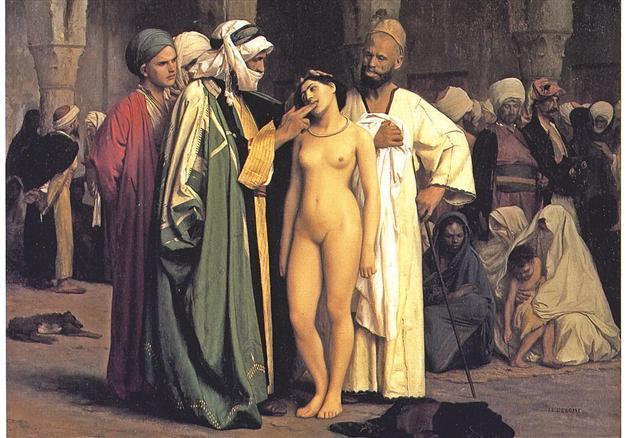Women, virginity and honor among the Ottomans
NIKI GAMM

Examining a slave’ by Jean-Léon Gérôme.
Islam is a religion based on the patriarchal society of the 7th century A.D. A large portion of the rules it lays down, governing the society of that time and subsequent centuries, concern family and society. Some of these rules naturally concern women and where the rules were lacking, recourse would be made to the hadith (the sayings of the Prophet Muhammad) and customary law.The age of discernment for children was generally considered to be seven. At that time, boys would leave the harem or at least the care of women and start the education that would allow them to operate in the outside world, while girls would be kept at home. There, the girl would start to learn how to accomplish the tasks that she would be required to know as a wife. She would look after her younger siblings and learn how to cook, clean, sew, embroider and the like. If the family was well off, she might be taught how to sing, dance and play an instrument such as an “ud” or lute, in order to provide entertainment for her husband and other members of his harem. There was no reason for her to learn reading or writing because her guardian (father, paternal grandfather or, if they were no longer present, some other male relative who was a Muslim and deemed to be of good reputation) would look after her and her interests until she was married.
Until the girl reached puberty, she had a fair amount of freedom compared to her older sisters who had been married off. But it would be likely that her family would be considering to whom she should be married. The closer she came to puberty, the more likely she would be taken on visits to female relatives and friends, and on expeditions to the local hamams, with the intention of showing her off as a potential wife. She would also play a prominent role in serving coffee to women guests in her home for display purposes. This appears to be a reason why young women in the imperial harem were handpicked by the Valide Sultan (Queen Mother) to serve the sultan coffee. It increased the chances that he would choose one of them to sleep with him and possibly even bear him a son.
The Ottomans believed that - with puberty and sexual awareness usually between 12 and 14 years of age - it was much better for her to become aware within marriage, where she could be groomed to be a compliant wife by her husband and/or mother-in-law.
 Women and virginity
Women and virginityVirginity was prized because it signified that the girl hadn’t had sexual relations with a boy or man, ensuring that any offspring was her husband’s. The same was true for girls and women being sold as slaves. It would have been common knowledge that, if by accident her virginity couldn’t be proven, there were ways of making it appear so. The most important part of the marriage, which was essentially a contract, specified the amount of the dower. A higher amount was paid for a virgin. A woman could also refuse to have sexual relations with her husband until the terms of the dower set forth in the contract were fulfilled.
With marriage, her guardian should then have been her husband, however, boys only became legally mature at the age of 18 and girls at 17, leaving a question as yet unanswered as to whether or not the boy’s guardian then became the girl’s as well. But when the girl reached 17, she had the right to repudiate the arranged marriage and Ottoman court records such as those examined by Leslie Peirce and others have shown that this right was used. A girl could get her marriage annulled if it had been arranged by someone other than her official guardian but she had to declare this as soon as she reached puberty. A free woman of mature age, whether or not she was a virgin, could not be given by her guardian without her consent.
According to Uriel Heyd in his book, “Studies in Old Ottoman Criminal Law,” the parties involved usually went to court in person, as there were no professional lawyers such as in Europe. Sometimes the plaintiff, if a woman or a minor, would have authorized someone to represent him or her. This makes sense since the court might be held in a mosque courtyard or the home of the judge.
Women and honor
The concept of “honor” was associated with married women, not unmarried women, because it aimed at the protection of home and family. It was important for the woman’s reputation and for that of her husband. By honor was meant chastity, modesty and observation of the rules of gender separation. According to Leslie Peirce in an article on “Sexuality, Seniority and Social Order”: “The fastest way to jeopardize one’s reputation for honor was to engage in inappropriate social or sexual behavior with a member of the opposite sex with whom one does not have a blood relationship.”
Walter G. Andrews and Mehmet Kalpaklı in “The Age of the Beloveds” say: “In a society where the norm was for upper-class women (free women and slaves alike) to be kept from the prying eyes of non-family members, it was no compliment to a woman to be singled out as the object of erotic interest. For a man to be handsome was a positive attribute of his manliness. His honor could be defended by his own hand, and, if he was dishonored by his sexual behaviors, the fault and dishonor were his alone. Not so with a woman, whose honor was equivalent to the honor of her family, whose duty it was to protect her.”
Years ago the toast, “Şerefe” “To your honor!” was commonly used when men were drinking together. But this was a toast between men; one that women did not or should not use in Turkish society. It begs the question: Was it women who had honor in the Ottoman period? Or only men and families?
















